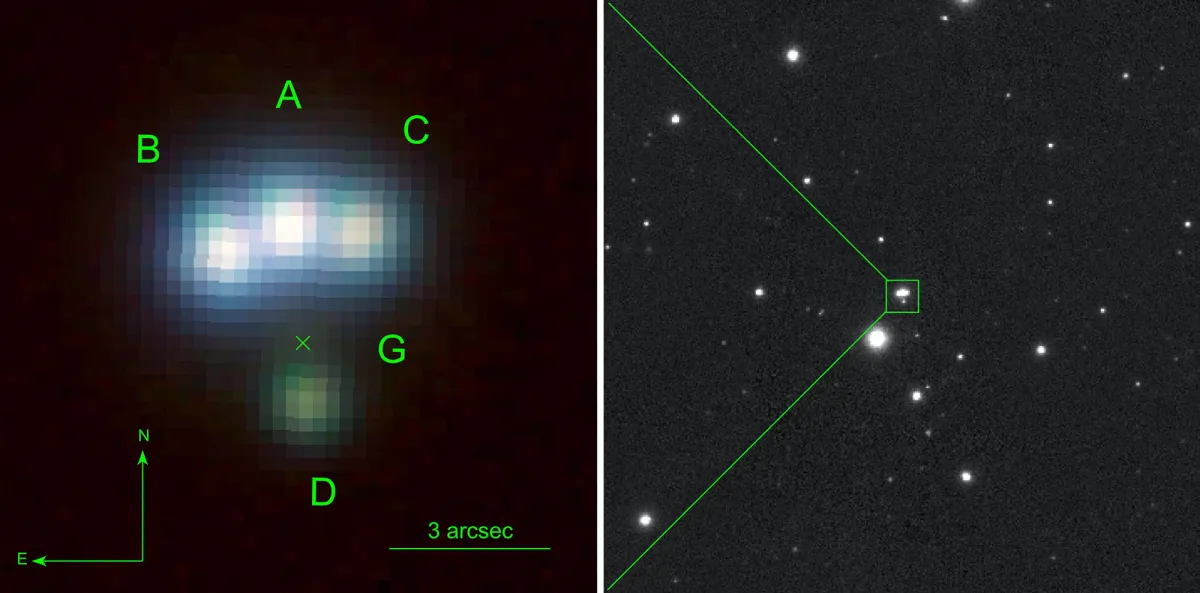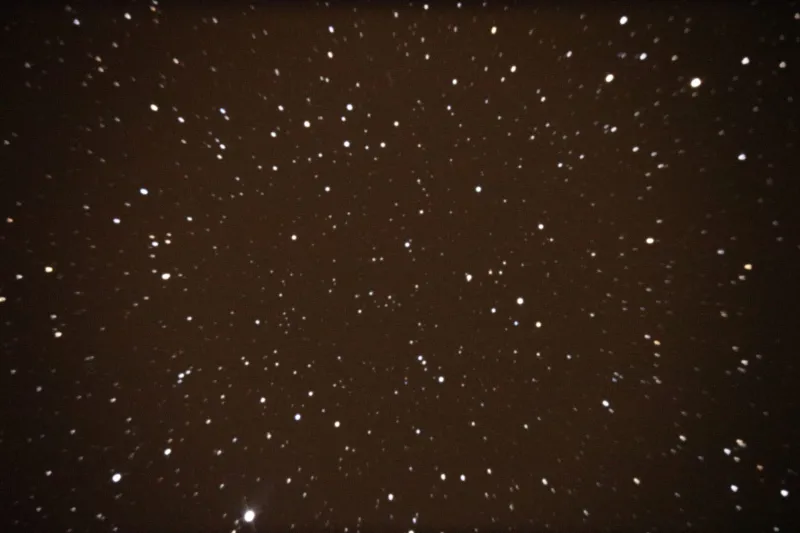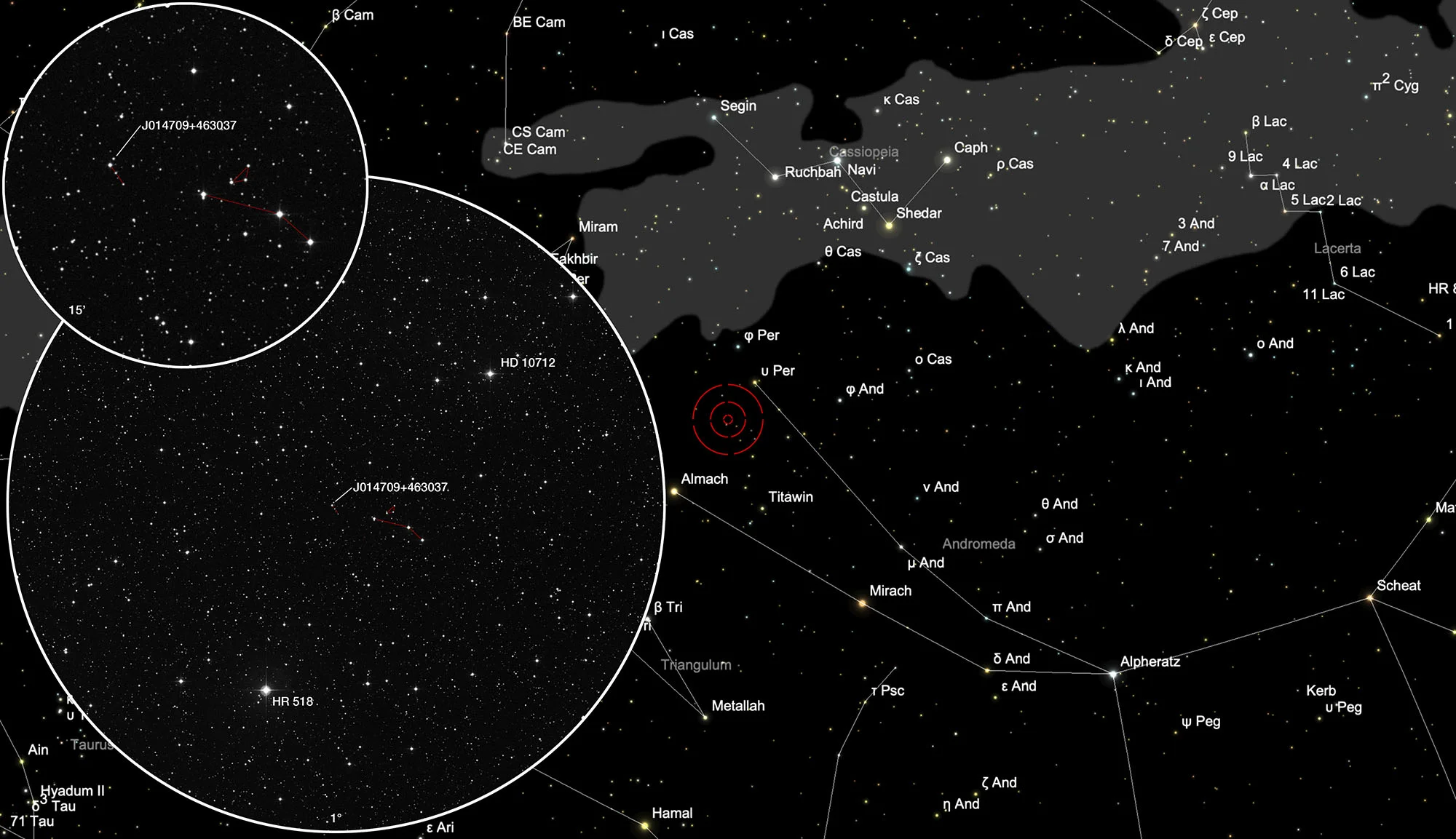Andromedas Parachute (Quasar J014709+463037)


History
The quasar J014709+463037 (also referred as PS J0147+4630, BNR2017 J014710+463040) was discovered by accident by Berghea et al. on images from December 2016 with the 1.8 metre Ritchey–Chrétien telescope on the summit of Haleakala on the Hawaiian island of Maui. The telescope is part of the «Panoramic Survey Telescope and Rapid Response System» (Pan-STARRS1). The J number sequence designates the coordinates in the ICRS J2000 coordinate system with HHMMSS+DDMMSS, relatively HHMM+DDMM. Since the discovery of the first gravitational lens quasar QSO 0957+561A/B in 1979 by Walsh et al. Such gravitational lenses became an important instrument for determining cosmological and Hubble constants.
Physical Properties
This quasar is a gravitational lens created by a galaxy in the foreground, which creates a quadruple image of a quasar lying behind it, much further away. The apparent visual brightness of the four quasar images is in the range from 15.4 mag to 17.7 mag. The redshift is about z = 2.377 ± 0.007, which corresponds to a distance of about 11 billion light years. The redshift of the much weaker foreground galaxy is about z ≈ 0.57, i.e. a distance of about 7 billion light years. J014709 + 463037 is one of the few quadruple gravitational lenses with z > 2, whose individual images are relatively bright and can be resolved by earth-based telescopes. [329, 330]
| Name | [BNR2017] J014710+463040 source |
| Object Type | Quasar |
| Right Ascension (J2000.0) | 01h 47m 10s |
| Declination (J2000.0) | +46° 30' 41" |
| Radial velocity | 250494 km/s |
| Redshift z | 2.341 |
| Identifiers | [BNR2017] J014710+463040 source |
Finder Chart
The quasar J014709+463037 is located in the constellation Andromeda between the stars υ Persei and Almach (γ Andromedae), about 2.5° from υ Persei. Between the two 35 arcminutes distant stars HR 518 (6.3 mag) and HD 10712 (7.9 mag) one looks for the star patterns shown in the 1° and 15 arcminutes closeup. On 23 October it is in opposition to the Sun and crosses the meridian at local midnight. The best observation time is June to March.
Visual Observation

400 mm Aperture: The position of the quasar could be well determined based on the surrounding stars. In the 9 mm Nagler eyepiece, the quasar was recognizable when seen indirectly, and it even occasionally flashed when viewed directly. Any extension or separation of components was beyond perceptibility. — 400 mm f/4.5 Taurus Dobsonian, Hasliberg, 17. 12. 2023, SQM 21.2, Bernd Nies
762 mm Aperture: Four components within 3 arcseconds, visually and photographically not separable. Quick and easy to find with the help of the location cards, can be clearly identified by means of surrounding stars. Identification in the photo because of similarly large and illuminated stars is more difficult as a visual sighting. — 30" SlipStream-Dobson f/3.3, Hasliberg, 25. 10. 2019, Eduard von Bergen
762 mm Aperture: Andromeda's parachute, more precisely the quasar J014709+463037, appears relatively fuzzy but clear. One had the feeling that one or the other individual component could be seen sporadically, but it could not be categorised in any way. — 30" SlipStream-Dobson f/3.3, Hasliberg, 31. 10. 2024, SQM-L 21.17, Eduard von Bergen
